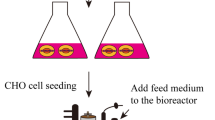Abstract
This work presents data on the carbohydrate and amino acid metabolism of a lymphoblastoid cell line producing an IgG1 antibody. In static culture, it was observed that lactate levels were significantly lowered when the cells were cultured on galactose as a carbon source. The use of carbohydrate substitution may be useful in lowering lactate levels, if it is established that this component is toxic to the cells. In addition, carbohydrate substitution may be used to modify glycosylation patterns and hence pharmacokinetic properties of glycoproteins.
The amino acids glutamine and tryptophan were shown to be limiting in batch culture on this medium (DR, a 1:1 mixture of DMEM and RPMI, with 4mM glutamine). Amino acids produced included alanine, proline and glutamate. Serine was consumed to exhaustion, which was followed by a depletion of extracellular glycine. Amino acid metabolism, specific antibody productivity and specific growth rate were shown to be functions of the inoculation density in stirred flask culture. The results have implications for the design of media for both low and high density antibody manufacture by these cell lines.
Similar content being viewed by others
References
Board M, Humm S and Newsholme EA (1990) Maximum activities of key enzymes of glycolysis, glutaminolysis, pentose phosphate pathway and tricarboxylic acid in normal, neoplastic and suppressed cells. Biochem J 265: 503–509.
Bushell ME, Bell SL, Scott MF, Snell K, Spier RE, Wardell JN and Sandeers PG (1993) A three-phase pattern in growth, monoclonal antibody production and metabolite exchange in a hybridoma bioreactor culture. Biotechnol. Bioeng. 42: 133–139.
Chotigeat W, Watanapokasin Y, Chin C, Mahler S and Gray PP (1994) Role of environmental conditions on expression levels, glycoform pattern and levels of sialyl transferase enzymes for r-FSH produced by recombinant CHO cells. Cytotechnology (in press).
Chua F, Oh SKW, Yap M, and Teo, WK (1992) eRDF medium enhances antibody production of IgG and IgM secreting hybridomas. In: Animal Cell Technology: Basic and Applied Aspects. Vol. 5, pp. 391–396. (roceedings of the 5th International Meeting of the Japanese Association for Animal Cell Technology Nov. 30–Dec. 4, Omiya, Japan), Kaminogawa S, Ametani A, and Hachimura S. (eds), Kluwer, Dordrecht.
Eagle H (1955) Nutrition needs of mammalian cells in tissue culture. Science 122: 501–504.
Franek F and Dolnikova J (1991) Hybridoma growth and monoclonal antibody production in iron-rich protein-free medium: effect of nutrient concentration. Cytotechnology 7: 33–38.
Glacken MW (1988) Catabolic control of mammalian cell cultures. Bio/Technology 6: 1041–1048.
Haggstrom L (1991) The energetics of glutaminolysis—a theoretical evaluation. In: Production of biologicals from animal cells in culture. Spier RE, Griffiths JB and Meignier B (eds), Butterworth-Heinemann, Oxford, pp. 79–81.
Jo E-C, Park H-J, Park J-M and Kim K-H (1990) Balanced nutrient fortification enables high-density hybridoma cell culture in batch culture. Biotechnol Bioeng 36: 717–722.
Kilburn DG and Webb C (1968) The cultivation of animal cells at controlled dissolved oxygen partial pressure. Biotechnol Bioeng 10:801–814.
Kovar J and Franek F (1987) Iron compounds at high concentrations enable hybridoma growth in a protein-free medium. Biotechnol Letts 9(4): 259–264.
Kun E and Kearney EB (1974). In: Methods of Enzymatic Analysis, 2nd Edn, Verlag Chemie, Weinheim, pp. 1802–1806.
Marquis CP, Barford JP and Harbour C (1993a) Fed-batch propagation of mouse hybridoma and human lymphoblastoid cell lines. In: Animal Cell Technology: Basic and Applied Aspects. Vol. 5, Kaminogawa S, Ametani A and Hachimura S (eds.), pp. 425–431.
Marquis CP, Barford JP, Harbour C and Nobbs D (1993b) Evaluation of the batch kinetics of the amino acid metabolism of a mouse hybridoma and human lymphoblastoid cell line using a pre-column FDNDEA derivitisation, HPLC technique. Biotechnol Techn 7(11): 799–804.
Marquis CP, Barford JP and Harbour C (1995) Amino acid metabolism during batch culture of a marine hybridoma, AFP-27. Cytotechnology (see this issue).
Miller WM, Wilk CR and Blanch HW (1987) Effects of dissolved oxygen concentration on hybridoma growth and metabolism in continuous culture. J Cell Physiol 132: 524–530.
Miller WM, Wilke CR and Blanch HW (1988b) Transient responses of hybridoma metabolism to changes in the oxygen supply rate in continuous culture. Bioprocess Eng 3: 103–111.
Ozturk SS and Palsson BO (1990) Effects of dissolved oxygen on hybridoma cell growth, metabolism and antibody production kinetics in continuous culture. Biotechnol Prog 6: 437–446.
Pedersen PL (1978) Tumour mitonchondria and the bioenergetics of cancer cells. Prog Exp Tumour Res 22: 190–274.
Reid S, Randerson DH and Greenfield PF (1987) Amino acid determination in mammalian cell culture medium. Aust J Biotechnol 1(2):69–72.
Reitzer LI, Burton MW and Kennel D (1979) Evidenec that glutamine, not sugar is the major energy source for cultured HeLa cells. J Biol Chem 254(8): 2669–2676.
Salleh M and Ardawi M (1988) Glucose and glutamine metabolism in human peripheral lymphocytes. Metabolism 37(1): 99–103.
Schmid G, Blanch HW and Wilke CR (1990) Hybridoma growth, metabolism and product formation in HEPES-buffered medium: 2. Effect of pH. Biotechnol Letts 12(9): 633–638.
Stark NJ and Heath EC (1979) Glucose-dependent glycosylation of secretory glycoprotein in mouse myeloma cells. Arch Biochem Biophys 192(2): 599–609.
Togami M, Yasada K and Karlya M (1991) Serum-free medium for marine and human lymphoid cell lines. Cytotechnology 6: 33–38.
Turco SJ (1980) Modification of oligosaccharide-lipid synthesis and protein glycosylation in glucose-deprived cells. Arch Biochem Biophys 205(2): 330–339.
Wagner A, Marc A, Engasser JM and Einsele A (1991) Growth and metabolism of human tumour kidney cells on galactose and glucose. Cytotechnology 7: 7–13.
Zielke HR, Ozand PT, Tildon JT, Sevddalian DA and Cornblath M (1978) Reciprocal regulation of glucose and glutamine utilization in cultured diploid fibroblasts. J Cell Physiol 95: 41–48.
Zielke HR, Sumbilla CM, Sevdalian DA, Hawkins RL and Ozand, PT (1980) lactate: a major product of glutamine metabolism by human diploid fibroblasts. J Cell Physiol 104: 433–441.
Author information
Authors and Affiliations
Rights and permissions
About this article
Cite this article
Marquis, C.P., Barford, J.P., Harbour, C. et al. Carbohydrate and amino acid metabolism during batch culture of a human lymphoblastoid cell line, BTSN6. Cytotechnology 21, 121–132 (1996). https://doi.org/10.1007/BF02215662
Received:
Accepted:
Issue Date:
DOI: https://doi.org/10.1007/BF02215662




